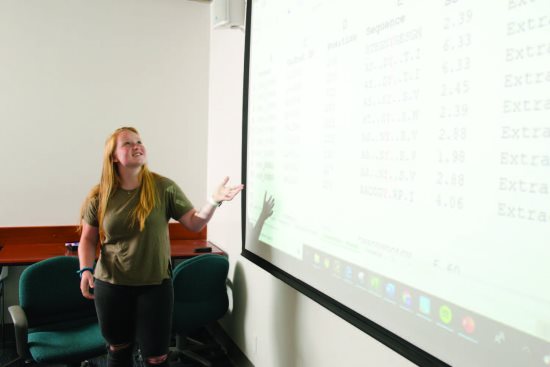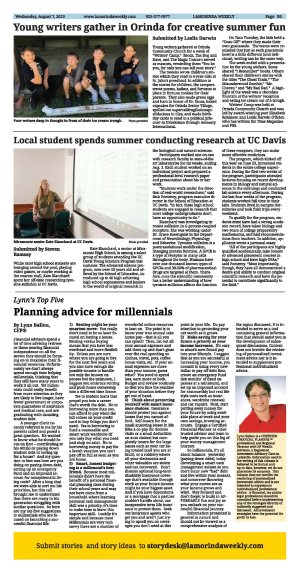| | Published August 7th, 2019
| Local student spends summer conducting research at UC Davis
| | | Submitted by Steven Ramsay |  | | Miramonte senior Kate Blanchard at UC Davis. Photo provided |
While most high school students are lounging around the pool, playing video games, or maybe working at the nearest mall, Kate Blanchard spent her off-time researching tyrosine sulfation at UC Davis.
 Kate Blanchard, a senior at Miramonte High School, is among a select group of students attending the UC Davis Young Scholars Program this summer. The advanced science program, now over 50 years old and offered by the School of Education, introduced up to 40 high achieving high school sophomores and juniors to the world of original research in the biological and natural sciences.
Kate Blanchard, a senior at Miramonte High School, is among a select group of students attending the UC Davis Young Scholars Program this summer. The advanced science program, now over 50 years old and offered by the School of Education, introduced up to 40 high achieving high school sophomores and juniors to the world of original research in the biological and natural sciences.
 Participants worked one-on-one with research faculty in state-of-the art laboratories for six weeks, ending Aug. 3. Each student worked on an individual project and prepared a professional-level research paper and presentation about his or her work.
Participants worked one-on-one with research faculty in state-of-the art laboratories for six weeks, ending Aug. 3. Each student worked on an individual project and prepared a professional-level research paper and presentation about his or her work.
 "Students work under the direction of real-world researchers," said Rick Pomeroy, program executive director in the School of Education at UC Davis. "In fact, these high school students are engaged in research that most college undergraduates don't have an opportunity to do."
"Students work under the direction of real-world researchers," said Rick Pomeroy, program executive director in the School of Education at UC Davis. "In fact, these high school students are engaged in research that most college undergraduates don't have an opportunity to do."
 Blanchard was investigating tyrosine sulfation in G-protein-coupled receptors. She was working under Dr. Grace Rosenquist in the Department of Neurobiology, Physiology and Behavior. Tyrosine sulfation is a posttranslational modification, changing protein function. A GPCR is a type of receptor in many cells throughout the body. Humans have over one-thousand known types of GPCRs and 30-50% of pharmaceutical drugs are targeted at them. Therefore, once the scientific community has a better understanding of how tyrosine sulfation affects the function of these receptors, they can make more effective medicines.
Blanchard was investigating tyrosine sulfation in G-protein-coupled receptors. She was working under Dr. Grace Rosenquist in the Department of Neurobiology, Physiology and Behavior. Tyrosine sulfation is a posttranslational modification, changing protein function. A GPCR is a type of receptor in many cells throughout the body. Humans have over one-thousand known types of GPCRs and 30-50% of pharmaceutical drugs are targeted at them. Therefore, once the scientific community has a better understanding of how tyrosine sulfation affects the function of these receptors, they can make more effective medicines.
 The program, which kicked off this year on June 23, immersed students in the entire college experience. During the first two weeks of the program, participants attended lectures focusing on recent developments in biology and natural sciences in the mornings and conducted lab science every afternoon. During the last four weeks of the program, students worked full time in their labs. Students lived in campus dormitories and took field trips every weekend.
The program, which kicked off this year on June 23, immersed students in the entire college experience. During the first two weeks of the program, participants attended lectures focusing on recent developments in biology and natural sciences in the mornings and conducted lab science every afternoon. During the last four weeks of the program, students worked full time in their labs. Students lived in campus dormitories and took field trips every weekend.
 To qualify for the program, students must have had a strong academic record, have taken biology and two years of college preparatory mathematics, and had recommendations from teachers. In addition, applicants wrote a personal essay.
To qualify for the program, students must have had a strong academic record, have taken biology and two years of college preparatory mathematics, and had recommendations from teachers. In addition, applicants wrote a personal essay.
 "All of the participants are highly qualified academically, take honors or advanced placement courses in high school and have high GPAs," said Pomeroy. "Most importantly, though, they have all demonstrated a desire and ability to conduct original scientific research and have the potential to contribute significantly to the field."
"All of the participants are highly qualified academically, take honors or advanced placement courses in high school and have high GPAs," said Pomeroy. "Most importantly, though, they have all demonstrated a desire and ability to conduct original scientific research and have the potential to contribute significantly to the field." |
| | | | | | | | | | | | |



